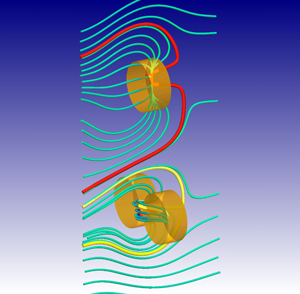A modern twist on Young’s slits

Example of the energy flow and optical vortices found around closely spaced gold nanoparticles. The effects resemble the field lines seen in Young’s slit experiments. Copyright : 2014 A*STAR Data Storage Institute
In the eighteenth century, scientists faced a conundrum: is light a wave or a particle? One of strongest pieces of evidence to support the ‘wave view’ — the landmark double-slit experiment — was reported in 1804 by the scientist Thomas Young. Young passed coherent light through two closely spaced slits and observed a set of interference fringes, a result that occurs with wave phenomena like sound or water. This observation became the basis for the modern wave theory of light.
Two hundred years later, Arseniy Kuznetsov and co-workers from the A*STAR Data Storage Institute, together with collaborators in Australia, Singapore, the United Kingdom and Russia, have performed an experiment analogous to Young’s experiments but using nanoscale objects (1). The team studied the light scattering in the visible and near-infrared wavelength regions from a cluster of two or three closely spaced gold plasmonic nanoparticles. They observed interference and resonance effects that resemble those seen in Young’s experiments.
In particular, while studying a trimer system consisting of three discrete metallic nanodisks of about 145 nanometers in diameter and 60 nanometers thick, the team found evidence for the presence of near-field, subwavelength-sized optical vortices and the circulation of electromagnetic energy (see image). This finding is very similar to what occurs to the energy flow pattern in a Young-type experiment performed with three slits.
One of the key issues in nanoplasmonics is the interaction between metallic nanoparticles at the nanoscale. “Even if the separation between two or multiple non-periodically arranged nanoparticles is of the order of wavelength, their interaction can be strong enough to change their scattering and absorption properties,” notes Kuznetsov. “This can be explained by the peculiarities of the Poynting vector (energy) flow around the nanoparticles and formation of optical vortices, which produce a pattern of field lines similar to Young’s classic experiment.”
The team’s findings, says Kuznetsov, not only expand our fundamental understanding of how light interacts with nanoclusters of metallic particles, but have both theoretical and practical applications. “They may also prove useful for applications such as improved solar cells and plasmonic biosensors.” However, their most remarkable application, he suggests, may be in the emerging area of nanoantennas.
In the future, the team is aiming to study the resonant properties and interactions of nanoparticles made from nonmetallic materials. In particular, they plan to investigate high-refractive index dielectric materials such as silicon, which, unlike metallic particles, do not suffer from high optical losses.
The A*STAR-affiliated researchers contributing to this research are from the Data Storage Institute
Associated links
Journal information
Rahmani, M., Miroshnichenko, A. E., Lei, D. Y., Luk’yanchuk, B., Tribelsky, M. I. et al. Beyond the hybridization effects in plasmonic nanoclusters: Diffraction-induced enhanced absorption and scattering. Small 10, 576–583 (2013).
Media Contact
All latest news from the category: Physics and Astronomy
This area deals with the fundamental laws and building blocks of nature and how they interact, the properties and the behavior of matter, and research into space and time and their structures.
innovations-report provides in-depth reports and articles on subjects such as astrophysics, laser technologies, nuclear, quantum, particle and solid-state physics, nanotechnologies, planetary research and findings (Mars, Venus) and developments related to the Hubble Telescope.
Newest articles

High-energy-density aqueous battery based on halogen multi-electron transfer
Traditional non-aqueous lithium-ion batteries have a high energy density, but their safety is compromised due to the flammable organic electrolytes they utilize. Aqueous batteries use water as the solvent for…

First-ever combined heart pump and pig kidney transplant
…gives new hope to patient with terminal illness. Surgeons at NYU Langone Health performed the first-ever combined mechanical heart pump and gene-edited pig kidney transplant surgery in a 54-year-old woman…

Biophysics: Testing how well biomarkers work
LMU researchers have developed a method to determine how reliably target proteins can be labeled using super-resolution fluorescence microscopy. Modern microscopy techniques make it possible to examine the inner workings…





















